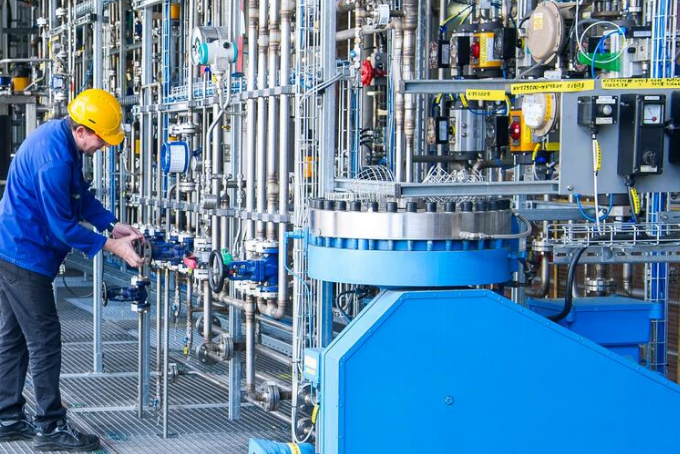Germany invests 700 million euros in hydrogen projects.
Three major research projects with industry are to make hydrogen a growth driver – and Germany a technology leader.
Federal Research Minister Anja Karliczek (CDU) is stepping up the pace on hydrogen: She is providing a total of 700 million euros for three major research projects with numerous industrial companies. These are intended to enable the series production of plants for the production of hydrogen, so-called electrolysers, in Germany.
In addition, the aim is to research the most cost-effective ways of transporting hydrogen worldwide and to advance the technology to produce hydrogen on the high seas using wind power on site. The project plans, which will be presented Wednesday, are available to Handelsblatt.
The research is intended to flank the hydrogen strategy of the German government, which wants to use it to achieve climate targets and at the same time capture a market worth billions. A study for the EU considers more than 5.4 million jobs and more than 800 billion euros in sales possible in a European hydrogen industry by 2050.
The EU has set itself the goal of becoming the technology leader in hydrogen. In summer 2020, the German government announced an additional seven billion euros in funding for its market establishment.
Research Minister Karliczek says everything is still going too slowly: “Germany and Europe must be wide awake here, also for economic reasons, and continue to step up their commitment. I am not yet entirely satisfied with the pace in Germany.
We need to pull together even more,” she told Handelsblatt, referring to the Ministry of Economics. Cooperation within the German government on this key technology is not yet considered optimal.
In the meantime, many countries have recognized the potential: “Hydrogen strategies are being published worldwide, countries are massively intensifying their efforts – I’m thinking here of Australia, Japan, South Korea, but also countries in Africa and the Middle East,” Karliczek said. To make 2021 a year of green hydrogen, she said she wants to “step it up a few notches” in promoting innovation together with the federal government’s “Green Hydrogen” innovation officer, Stefan Kaufmann.
The projects selected in 2020 in the “Hydrogen Republic of Germany” ideas competition are now being run by industry-led consortia. In total, almost 100 major companies such as Siemens, Thyssen and RWE are involved, as well as a good 30 smaller ones. Others could join them, according to the ministry.
The largest project is “H2Giga”: It is intended to develop the technology for series production of electrolysers – production plants that could then be exported worldwide. After all, green hydrogen is the cheapest to produce where there is plenty of solar and wind energy.
High-performance plants already exist, but they are still largely manufactured piece by piece by hand. The goal is therefore now the assembly line production of three different electrolyzers for “PEM”, alkaline and high-temperature electrolysis.
The consortium, coordinated by “Dechema Gesellschaft für Chemische Technik und Biotechnologie,” brings together 112 partners from industry and science, including Thyssen-Krupp, Siemens, Linde/ITM-Power, MAN/HTEC, Sunfire, Schaeffler, Evonik and Shell.
The second project, “TransHyDE,” is intended to develop transport options for hydrogen, because in addition to gas networks, completely new technologies are needed here. The focus is on transport in high-pressure containers, as a liquid or bound in ammonia. This includes the development of standards and safety regulations as well as the development of suitable materials.
The 89 partners are coordinated by RWE Renewables GmbH, the Max Planck Institute for Chemical Energy Conversion and the Fraunhofer Institute for Energy Infrastructure. RWE, GRTgaz Deutschland, ONTRAS Gastransport and Open Grid Europe GmbH are also involved.
The “H2Mare” consortium, led by Siemens Energy, is to research the production of green hydrogen on the high seas, which would also be a good option for Germany. According to the ministry, such offshore production of green hydrogen and other so-called “power-to-x” products is “unique to date” and has “the potential to develop a global lighthouse effect from Germany. If successful, new export opportunities for Germany can arise from the technology.”
However, the special conditions at sea place high demands on the design, material and operation of the plants. Research here is therefore about fundamental investigations as well as extensive technology development.
The prospects are enticing, he said, because offshore wind farms generate more electricity, and more regularly – about 5 megawatts on average, compared with 3.5 megawatts on land. In addition, there is much more space for wind farms at sea.
In addition, “direct coupling of wind turbine and electrolyzer would minimize the cost of hydrogen production,” the concept says. In addition, coupled production at sea could relieve the strain on land-based grids. In addition to Siemens, RWE and Salzgitter Mannesmann Forschung GmbH are also involved.
As far as research into production in the immediate vicinity of offshore wind turbines is concerned, in addition to hydrogen, the focus will also be on green methane, methanol, ammonia and synthetic fuels.







